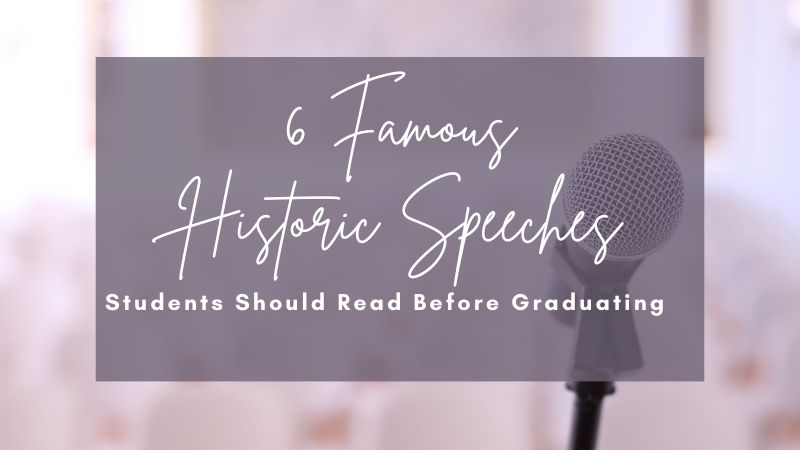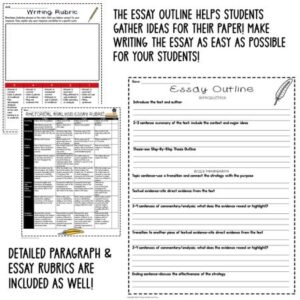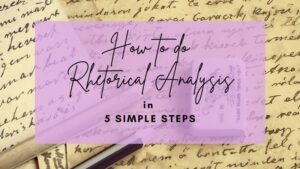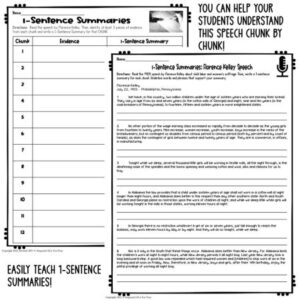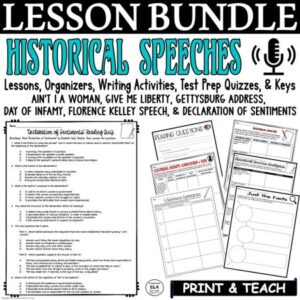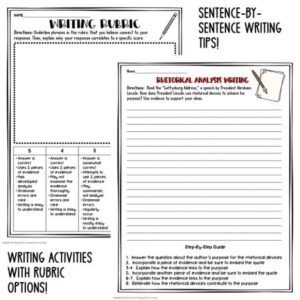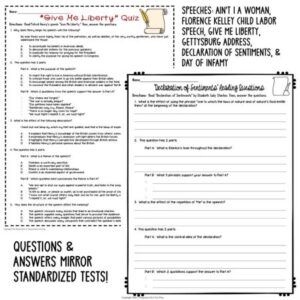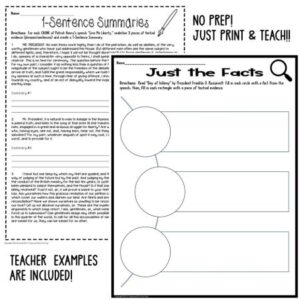You know the saying that “those who cannot remember the past are condemned to repeat it?” This quote is often paraphrased and attributed to different philosophers including Edmund Burke; however, the line is originally from Spanish-American philosopher George Santayana. The fact that the attribution is often misremembered is ironic considering the statement’s message! Clearly, remembering and knowing the past is important, particularly when it comes to Famous Historic Speeches!
So much of our lives and those of our students were decided by people who lived long before us. In order to understand those decisions and find ways to support or subvert them, it’s important to have familiarity with US history and the famous historic speeches that mark those moments.
Additionally, public speeches are great mentor texts for studying rhetoric and the use of pathos, ethos, and logos. In examining these important historical speeches, students can analyze how speakers used emotions to convince their listeners to take action or what facts were used to support opinions that, for some, seemed rebellious in their moment. Through that analysis, students can apply their learning to their own persuasive writing. Who knows? One day our students may produce Famous Historic Speeches!
To that end, here are six famous historic speeches that every student should study before they graduate from high school!
Need help with Test Prep? Check out this FREE Pack of 3 Test Prep Activities to help students achieve success on standardized tests!
6 Famous Historic Speeches
1. Patrick Henry’s “Give Me Liberty” Speech –
This 1775 speech features the famous line “Give me liberty or give me death!” During a time of British oppression, Patrick Henry calls for war. The above iconic line is delivered after a discussion of whether or not peace was possible, and it demonstrates a passionate plea from Henry to leaders in colonial America. That line alone makes the speech one of the most Famous Historic Speeches. It is monumental and worthy of study, particularly for an examination of pathos, logos, and ethos.
Use this bundle of activities to complete a summary, ensure reading comprehension, and explore the use of rhetoric in the speech.
2. FDR’s “Infamy” Speech –
Franklin D. Roosevelt’s speech on December 8, 1941–the day after the bombing of Pearl Harbor by Japanese forces–drew the United States into the Second World War. His reasoning and call to war were necessary for a tumultuous time! Reading and writing activities for this speech might focus on parsing fact from emotion, particularly when the day before is considered through a historical lens.
This bundle of activities with a focus on emotions versus facts also encourages students to examine the author’s purpose. It will save you time and effort when teaching this speech in your History, English, or Social Studies classes.
Need help with teaching rhetorical analysis beyond Famous Historic Speeches? Click to read “5 Simple Steps for How to Do Rhetorical Analysis” for help!
3. Abraham Lincoln’s “Gettysburg Address” –
Delivered in Pennsylvania at Gettysburg National Cemetery during the Civil War, this speech by US President Abraham Lincoln is a key part of American history. From its opening line in reference to the signing of the Declaration of Independence–“Four score and seven years ago”–to its conclusion a short 10-lines later, the speech is impactful despite its brevity. As a result, studying the use of connotation to establish tone is an ideal way to analyze it.
Check out this bundle of activities with no-prep activities to guide your students in understanding Lincoln’s famous historic speech.
4. Elizabeth Cady Stanton’s “Declaration of Sentiments” – One of the most defining famous historic speeches for women’s rights!
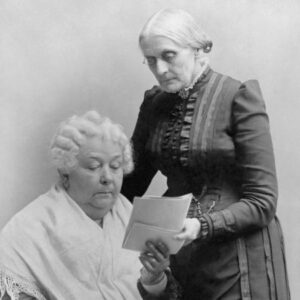
This 1848 speech was given during the first women’s rights convention in Seneca, New York. The Declaration itself is so named for its similarity to the US Declaration of Independence. One idea for a lesson featuring this speech is to compare it to the wording of the historic document. You could begin such a lesson with these summary activities that focus on rhetorical analysis. In small groups, students could then break down the language that is shared between the two documents to discuss the speech’s effectiveness.
5. Sojourner Truth’s “Ain’t I a Woman? –
Delivered in 1851 at the Women’s Rights Convention in Ohio, Sojourner Truth’s speech focused on equality based on both race and gender. As an abolitionist and women’s rights activist, Truth’s speech is now well-known, but it took more than a decade after it was first delivered to gain widespread popularity. It is noteworthy though that there are discrepancies between the original text from 1851 and the reproduced version in 1863. This fact would make for a great lesson for any high school class.
Begin your study of the speech with these comprehensive resources for content, comprehension, and analysis.
6. Florence Kelley Child Labor Speech –
An activist for women’s rights and child labor reforms, Florence Kelley’s 1905 speech is a formidable addition to a list of famous historic speeches. Speaking to the National American Women Suffrage Association, Kelley advocated for an end to child labor in the United States. The speech provides ample opportunity to examine pathos, particularly with Kelley’s repetition of the line “While we sleep” to draw the listener into the experience of those little children who were not sleeping but rather at work in textile mills.
Use this activity to closely read Kelley’s speech. It includes a version of the speech in chunks to differentiate for the students in your class to write effective one-sentence summaries. Then with this step-by-step lesson, reading activities, templates (leading to an essay), and teacher examples, teaching rhetorical appeals is quick, easy, and stress-free!
Why Teach These Famous Historic Speeches?
The value of studying any or all of these famous historical speeches cannot be understated. Reading and examining speeches from history provides a window into the speeches of today. The use of the same rhetorical devices, appeals, language and more are drawn from history. Recognizing and acknowledging history is vital to personal growth, the development of critical thinking, and having an impact on our society. The issues raised in each of these speeches may feel distant in terms of timing but in a lot of ways, the content remains as relevant today as it did when the words were first spoken!
WANT AN EVERYTHING DONE FOR YOU BUNDLE, WHICH INCLUDES 6 FAMOUS HISTORIC SPEECHES? CLICK BELOW!
Need more fun lessons and activities for the end of the year? Check out my store Kristin Menke-Integrated ELA Test Prep!

